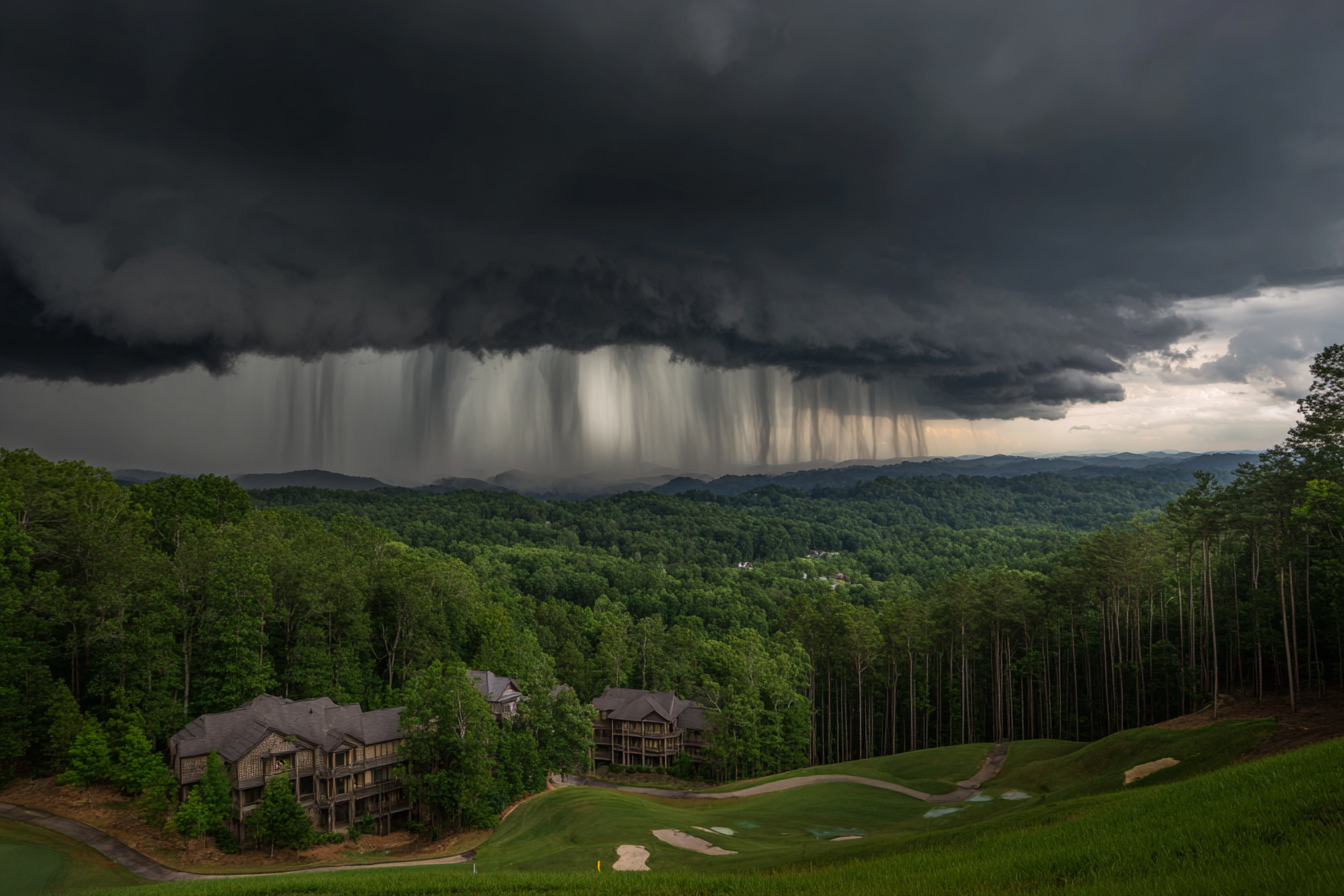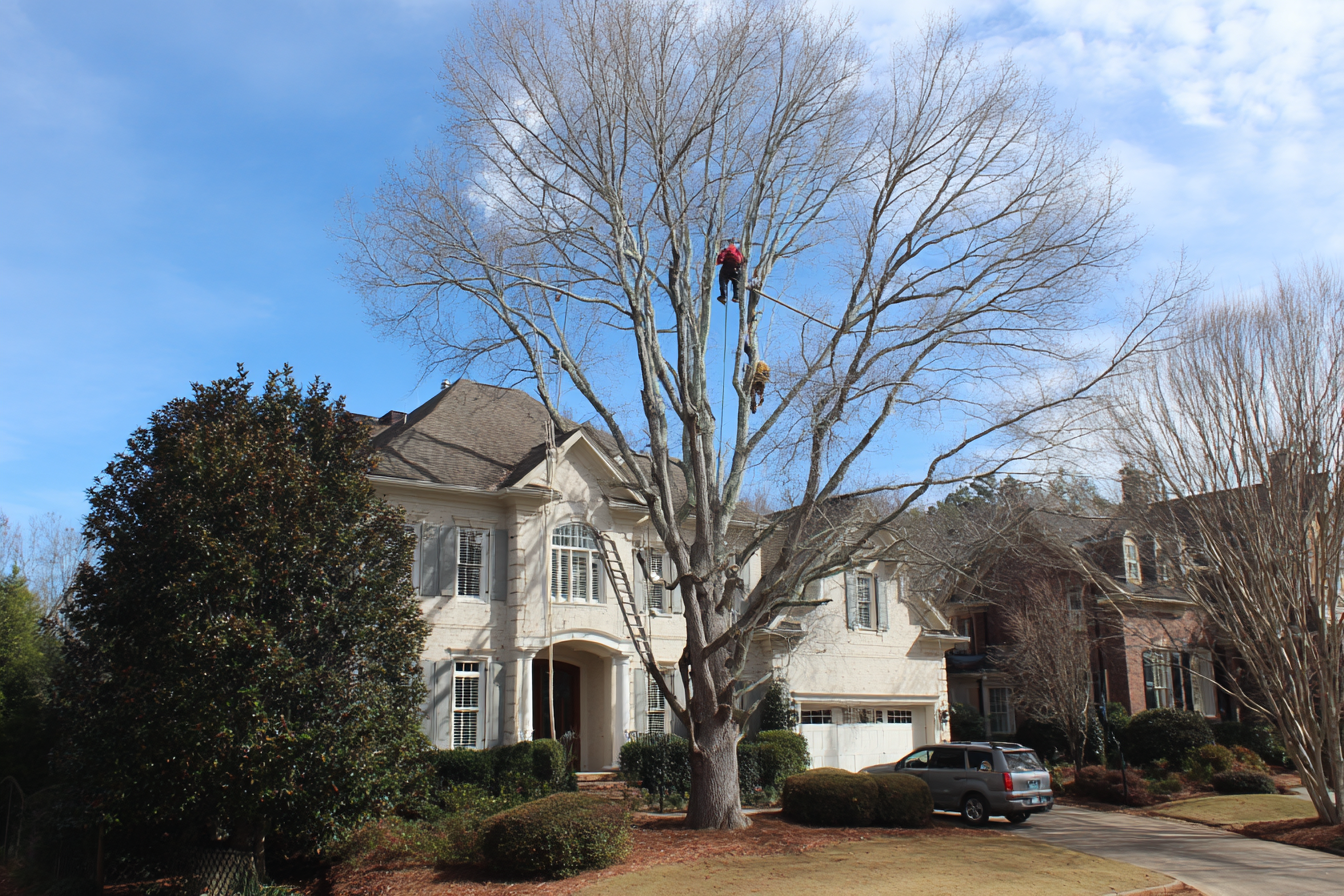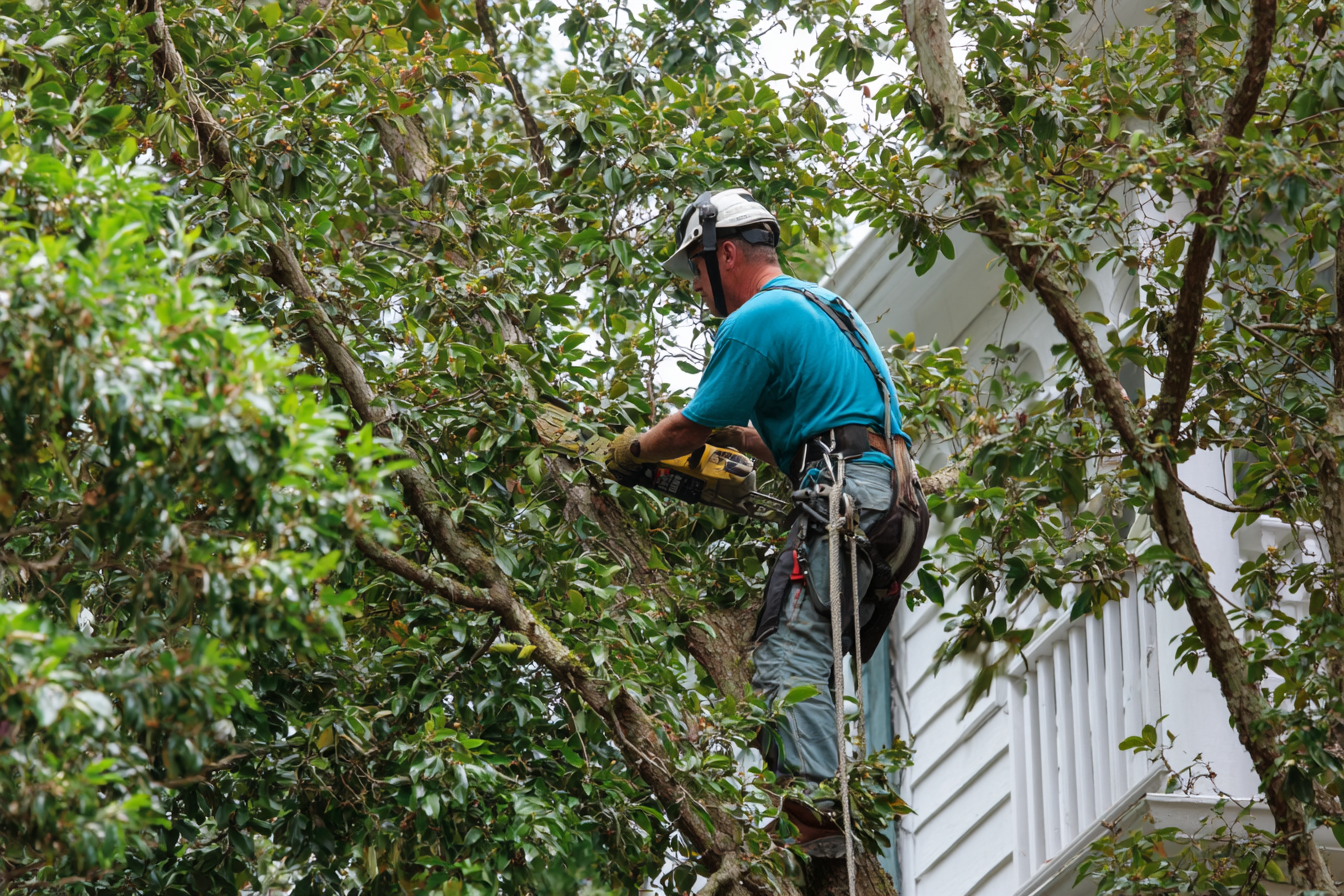
In Georgia, our landscapes are defined by majestic oaks, soaring pines, and beautiful dogwoods. These trees provide shade, beauty, and a sense of natural tranquility. However, they can also become a source of immediate danger and significant stress, especially when an unexpected event turns them into a hazard.
A sudden thunderstorm, a tropical storm, or a slow-spreading disease can transform a beloved tree into a liability. The threat of a massive limb crashing onto your roof, a trunk blocking your driveway, or a diseased tree silently decaying from the inside out is a reality for many homeowners. When a tree emergency strikes, you don't have time to hesitate. You need a plan, and you need to know who to call.
This comprehensive guide will walk you through everything you need to know about emergency tree services in Georgia. We'll cover what constitutes a true tree emergency, the common threats from storms and diseases, and the critical steps you must take to ensure the safety of your property and family. We'll also explain why choosing a professional, local service like Georgia Pro Tree Service is the most important decision you'll make in a crisis.
What is a Tree Emergency? The Urgency of the Situation
Not every tree problem requires an immediate, 24/7 response. However, certain situations are classified as emergencies due to the immediate risk they pose to life and property. Knowing the difference can help you react appropriately.
A true tree emergency is any situation where a tree or a major part of it has failed and is creating an immediate hazard. This includes:
- Fallen Trees: A tree has fallen on your house, a car, or other structures, causing damage.
- Hanging Limbs: Large, broken branches are suspended precariously in other parts of the tree, threatening to fall at any moment. These are often called "widow makers" and are incredibly dangerous.
- Blocked Access: A fallen tree is blocking your driveway, a public road, or an entrance to your home, preventing you from safely leaving or entering.
- Compromised Stability: A tree has been severely uprooted or is leaning at a dangerous angle, indicating it's about to collapse.
- Utility Line Interference: A tree or branch has fallen on a power line, posing a risk of electrocution and power outages.
In these scenarios, the danger is real and present. Attempting to handle the situation yourself is extremely risky and should never be considered. The complex and often unstable nature of a compromised tree requires the skills, equipment, and training of a professional emergency tree service.

Storm Damage: When Georgia's Weather Takes Its Toll
Georgia’s weather is famous for its sudden shifts and powerful storms. From the intense summer thunderstorms that sweep across the state to the tropical storms and hurricanes that track up from the coast, our trees are constantly put to the test.
High winds, heavy rainfall, and lightning strikes are the most common causes of storm-related tree emergencies. The force of a strong gust can snap a seemingly healthy tree in half or uproot it entirely. Waterlogged soil, a frequent side effect of a big storm, can make trees top-heavy and their root systems unstable, leading to an easy collapse. Lightning can split a tree down the middle, turning it into a splintered, explosive hazard.
Storm damage isn’t always obvious. While a tree on your roof is a clear emergency, many homeowners miss the subtle signs of a compromised tree after a storm. This is where a professional assessment is crucial. An expert arborist can identify hidden cracks in the trunk, root damage, or other structural weaknesses that may not be apparent to the untrained eye.
Proactive measures are the best way to prepare for storm season. Regular pruning and tree health assessments before a storm hits can dramatically reduce the risk of an emergency. However, when the storm has passed and you're left with the aftermath, a professional emergency crew is your only safe option.
The Silent Threat: How Disease Leads to an Emergency
While storm damage is a sudden event, tree diseases are a silent, progressive threat that can turn a healthy tree into a hazard over months or even years. In Georgia, our climate and ecosystem make certain tree diseases particularly prevalent.
- Oak Wilt: This is one of the most devastating diseases affecting oak trees, particularly the red oak species. It's a fungal disease that disrupts the tree's ability to transport water and nutrients, leading to rapid wilting and death. A tree suffering from advanced oak wilt can suddenly lose its structural integrity and fall without warning, creating an unexpected emergency.
- Root Rot (Phytophthora): Caused by soil-borne fungi, root rot attacks a tree's root system, leading to decay and instability. The visible signs may be subtle at first, like yellowing leaves or a general decline in health. However, as the root system weakens, the tree becomes a prime candidate for uprooting during even a mild windstorm. You may not know the tree is a risk until it’s too late.
- Anthracnose: A common fungal disease affecting many deciduous trees in Georgia, including dogwoods and maples. While it often causes leaf spots and premature leaf drop, severe cases can lead to branch dieback and weaken the tree, making it more vulnerable to storm damage.
Catching these diseases early is the best way to prevent an emergency. Regular tree inspections by a certified arborist can identify the signs of disease before it becomes a major problem. However, if a tree has become severely compromised, removal is often the safest and most responsible solution.
Navigating the Aftermath: What to Do in a Tree Emergency
When a tree emergency occurs, a clear head and a methodical approach are your best assets. Follow these steps to ensure safety and get the help you need:
- Prioritize Safety First: The most critical step is to ensure that all people and pets are moved to a safe location, away from the tree. Do not approach the tree or any hanging limbs. Be especially cautious of downed power lines. Assume any downed wire is live and stay far away.
- Contact Emergency Services (if necessary): If the fallen tree has damaged a home, a vehicle, or is blocking a road, call 911 immediately. They can secure the area and ensure a safe environment for first responders.
- Document the Damage: Take photos and videos of the damage from a safe distance. This documentation is crucial for your insurance claim and will provide the tree service company with the information they need to prepare for the job.
- Call a Professional Emergency Tree Service: This is the most important step. Don't attempt to handle the situation with a chainsaw or by yourself. A professional service like Georgia Pro Tree Service has the training, expertise, and heavy-duty equipment needed to safely remove the tree and clean up the area.
- Contact Your Insurance Company: After you've contacted a professional tree service, call your insurance provider to start the claims process. Many reputable tree services in Georgia can work directly with your insurance company, streamlining the process for you.

Why You Need a Professional: The Difference Between a Handyman and an Expert
In a crisis, it can be tempting to call the first person you find who offers to help. However, amateur tree removal is incredibly dangerous and often leads to more damage or injury. Professional emergency tree services are equipped to handle complex and hazardous situations.
- Experience and Training: Professional arborists and crew members are trained to assess the risks of a compromised tree. They understand the physics of a falling tree, the proper use of ropes and rigging, and the best cutting techniques to ensure a safe removal.
- Specialized Equipment: Emergency tree removal often requires heavy machinery, such as cranes, loaders, and large chippers. A professional company invests in this equipment to handle trees of all sizes and in all locations, including those in tight, urban spaces.
- Safety Protocols: Reputable companies have strict safety protocols and are fully licensed and insured. This protects their workers, your property, and you from liability if an accident were to occur.
- 24/7 Availability: A tree emergency doesn't wait for business hours. A professional emergency service offers 24/7 dispatch, ensuring you can get help the moment you need it, day or night.
The Georgia Pro Tree Service Difference
At Georgia Pro Tree Service, we understand the unique challenges that Georgia’s climate and landscape present to homeowners. Our team is made up of certified arborists and trained professionals who live and work right here in Georgia. We are committed to providing fast, safe, and reliable emergency tree services to our community.
We have the experience to handle every type of tree emergency, from hurricane-force wind damage to the removal of a long-diseased tree. Our state-of-the-art equipment and commitment to safety mean we can tackle even the most complex jobs with confidence and precision.
When you call us, you're not just getting a service, you're getting a partner in a crisis. We'll arrive promptly, assess the situation, and provide a clear, professional plan of action. We'll also work directly with your insurance company to make the process as seamless as possible. Our goal is to restore safety and peace of mind to you and your family.
Conclusion: Be Prepared and Know Who to Call
The beauty of Georgia's trees is a gift we all enjoy. But with that beauty comes responsibility. Proactive tree care is the best defense against a tree emergency. Regular health checks, strategic pruning, and timely disease management can prevent many disasters before they happen.
However, when the unexpected occurs, a fierce storm, a sudden disease, or a limb hanging by a thread, don't take chances. Your safety and the integrity of your property depend on a swift and professional response.
Call Georgia Pro Tree Service today for a free, no-obligation consultation on your tree care needs or for immediate assistance with a tree emergency. We're here to protect what matters most to you.
FAQs About Emergency Tree Services in Georgia
Q: What is the first thing I should do if a tree has fallen on my house in Georgia?
A: The absolute first thing you should do is ensure the safety of everyone in the house by moving them to a secure location. Do not approach the tree or try to assess the damage up close. Call 911 to report the incident, especially if there are any injuries or the tree has damaged power lines. After emergency services have secured the scene, call a professional emergency tree service like Georgia Pro Tree Service.
Q: Does my insurance cover emergency tree removal?
A: In many cases, yes. Most homeowner's insurance policies cover the cost of removing a tree and repairing property damage if the tree fell due to a covered peril, such as a storm, wind, or lightning. The coverage often extends to the cost of removing the tree from a structure, such as your house or garage. It is important to document all damage and contact your insurance company as soon as possible. Professional tree services like Georgia Pro Tree Service can often work directly with your insurance adjuster to facilitate the claims process.
Q: How can I tell if a tree is at risk of falling before a storm?
A: You can look for several warning signs, including:
- Leaning: A sudden or significant lean in the tree's trunk.
- Cracks: Deep cracks or splits in the trunk or major limbs.
- Dead Limbs: An excessive number of dead or hanging limbs, often called "widow makers."
- Fungus/Conks: The presence of mushrooms or other fungal growth at the base of the tree.
- Root Damage: Uprooted or exposed roots on one side of the tree.
- Cavities: Large holes or decayed sections in the trunk or main branches.
If you notice any of these signs, it's best to have a certified arborist from a company like Georgia Pro Tree Service inspect the tree to determine the risk.
Q: Is it safe to try and remove a fallen tree myself?
A: No, it is extremely dangerous to attempt to remove a fallen tree yourself, especially if it is large, has caused damage to a structure, or is near power lines. Fallen trees are under immense tension and can shift unpredictably, leading to severe injury or death. This is a job that requires specialized training, proper safety equipment, and heavy machinery, all of which professional tree services have.
Q: What common tree diseases in Georgia can lead to a tree emergency?
A: Several diseases can weaken a tree's structure over time, making it a hazard. Some of the most common in Georgia are:
- Oak Wilt: A deadly fungal disease that kills oak trees quickly.
- Root Rot: A fungal disease that attacks the root system, making the tree unstable.
- Anthracnose: A fungal disease that causes leaf spots and can lead to branch dieback.
Cankers: Sunken, dead areas on the trunk or branches caused by fungi or bacteria.If you suspect your tree has a disease, a professional arborist can diagnose the problem and recommend a course of action to either treat the tree or safely remove it before it becomes a hazard.

We're your local tree pros!
Georgia Pro Tree Services takes the highest quality of care when servicing your trees. Call us to find out how we can help you keep your yard in top shape.



